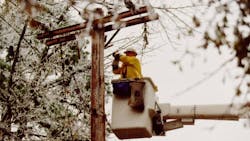Extreme Cold Calls for Different Power Restoration Process
The freezing conditions plaguing Louisiana and other parts of the United States have brought power outages over the last couple of days. But whether an outage is caused directly by the temperatures or something else, restoration becomes more complex because of the different way customers are restored once any needed repairs are made. There are certain steps Entergy must take to ensure power is restored safely and reliably, and there are steps customers can take to help as well.
“We use a methodical and calculated process in bringing customers back online after an outage in very cold weather like we’re having right now,” explained Dennis Dawsey, vice president of customer service for Entergy’s Louisiana utilities. “We have had some outages that were specifically weather-related, for example when winds blew debris onto lines or damaged electrical equipment, and other scattered outages across the state for a variety of reasons. But what our customers may notice is that if an outage occurs, regardless of the cause, restoration follows a different process.
“Rather than simply energizing an entire power line all at once, we are forced to bring customers back online one section at a time to avoid damage to our system and make the situation worse.”
The reason for the different process involves how much power—or load—is being used. During temperature extremes, hot or cold, customers tend to use a lot of electricity, either keeping the heat on or air conditioning running.
When an outage occurs, restoring all the customers on a given feeder (conductor line) has the potential to create large, instantaneous load. And that load could be higher than the built-in protective devices on a line can handle, meaning equipment could trip offline or cause more damage.
“We have devices in place that are designed to protect our system during normal load,” Dawsey said. “But during weather extremes, we must change our processes to make sure we protect our system and also do the right thing by our customers. That means restoring power in a way that best ensures safety and reliability for them as well as our employees.”
During extreme cold weather conditions, there are specific restoration challenges that are experienced not just by Entergy and other utilities in Louisiana, but throughout the industry and the country. First, a number of homes have both electric heat and air conditioning along with other electrical appliances, and an electric heating load exceeds a comparable air conditioning load. Another considerable issue is that when power is disrupted during winter, many customers leave their heating systems and appliances turned on.
“So when power is restored, those heating systems cause a huge drain on the electrical system all at once and can cause line-protection equipment to trip again,” said Dawsey. “That’s why we use a slower, more sequential process to restore electrical service after an outage during extreme cold weather. But there are some steps customers can and should take, as well, to help avoid a power surge that could further damage the electrical system and make the situation worse.”
Customers experiencing an outage during times of extreme cold should turn off their electric heating systems, lights and appliances during the outage and then, after power has been restored, turn them back on one at a time, over a period of time to help avoid a sudden power surge. For example, if you have an electric heating system, start by setting your thermostat to 65 degrees, then slowly raise it over time, rather than setting it immediately to a higher setting.
